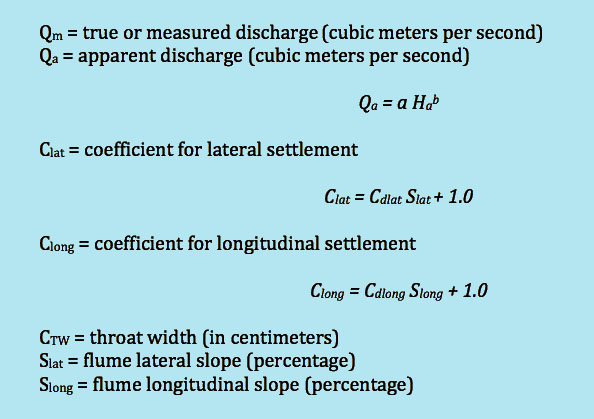This website uses a variety of cookies, which you consent to if you continue to use this site. You can read our Privacy Policy for
details about how these cookies are used, and to grant or withdraw your consent for certain types of cookies.
Filter By:
Settling
One requirement for a Parshall Flume to accurately measure flow is that the converging floor be set level from front-to-back and from side-to-side. However, because of the material weight, the unreinforced nature of natural channels, long-term consolidation of the foundation soils, and general installation errors, a flume may be installed off-level or may experience settlement over time. When this happens, the standard flow equation is no longer accurate.
Research at Colorado State University has resulted in the development of a generalized correction for settling which is applicable to both free and submerged flow conditions.
The true or measured discharge (Qm) may be determined by:

Where (with level measurements taken on the LEFT side of the flume looking downstream):

A negative lateral (crest) slope is when the RIGHT side of the flume - looking downstream, in the direction of flow - is lower than the flume-floor centerline.
A positive lateral slope is where the LEFT side is lower than the flume-floor centerline.

A negative longitudinal slope is where the flume entrance is LOWER than the exit of the flume. A positive longitudinal slope is where the flume entrance is HIGHER than the exit of the flume.


Where:

For submergence of less than 90%, the flow in an off-level Parshall Flume can be corrected to within +/- 3% of the true discharge. For submergence of 90% or greater, the flow can be corrected no better than +/- 5% of the true discharge.
These corrections were determined for:
- Parshall Flumes 1”, 2”, 3”, 12”, and 24” in size (although researches state their belief that the procedure should be applicable to larger flume sizes)
- Lateral slopes of -11.6% to 11.6%
- Longitudinal slopes of -10.5% to 10.5%

LOCATIONS IN ATLANTA, GA & BOISE, ID

